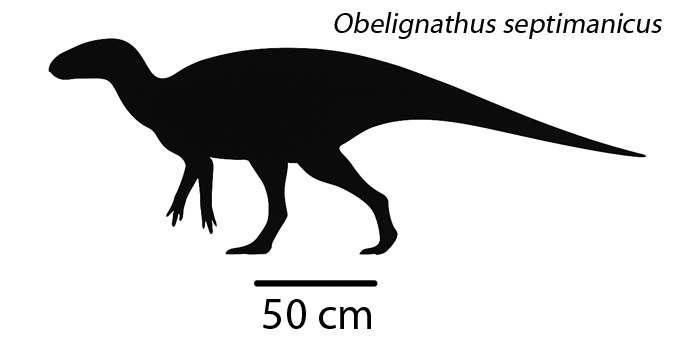“Obélix Jaw” – A New Late Cretaceous Ornithopod Dinosaur
Researchers have named a new genus and species of rhabdodontomorph ornithopod from fossil material found in southeastern France. The dinosaur has been named Obelignathus septimanicus. The genus name was inspired by the French cartoon strip character Obélix from the Asterix the Gaul series, and the Latin word for jaw. Obélix is known for his exceptional strength and robust appearance. This is a reference to the unusually robustly built holotype dentary.
The researchers conclude that rhabdodontomorphs were more diverse in Europe than previously recognised.

A silhouette of the recently described 2025 ornithopod Obelignathus septimanicus from the Grès à Reptiles Formation in southern France. Scale bar equals 50 cm. Picture credit: Everything Dinosaur.
Picture credit: Everything Dinosaur
Obelignathus septimanicus
The origins and early diversification of the Ornithopoda is poorly understood. For instance, the phylogeny of the Rhabdodontidae, a family of medium-sized ornithischian dinosaurs known solely from the Upper Cretaceous of Europe remains unresolved. Current studies suggest eight or nine species, all of which are known from the upper Campanian to lower Maastrichtian of Europe.
Writing in the journal “Scientific Reports”, the researchers compiled a novel dataset made up from a morphological assessment and measurements of rhabdodontomorph dentaries. The robust dentary (specimen number MDE D30) when first described in 1991 (Buffetaut and Le Loeuff), was thought to represent the genus Rhabdodon. However, it was sufficiently different to warrant its own species – Rhabdodon septimanicus. This latest analysis places R. septimanicus well outside the genus Rhabdodon and hence, a new genus has been erected.
Obelignathus is found to be a clear morphological outlier among European rhabdodontomorphs. The research team members conclude that further large-scale studies are required to clarify the taxonomy of European rhabdodontomorphs. These results indicate that this group of ornithopods exhibit greater diversity than currently recognised. Several taxa appear to be coeval.
In common with most other rhabdodonts Obelignathus was relatively small. It is thought to have measured under three metres in length.
A New Herbivore from Late Cretaceous France
The find underscores southern France’s importance as a hotspot for Late Cretaceous dinosaur diversity. As fieldwork continues, Obelignathus offers a glimpse into the complex web of life that once thrived on the European archipelago.
Everything Dinosaur acknowledges the assistance of the open access scientific paper in the compilation of this article.
The scientific paper: “Exploring the diversity and disparity of rhabdodontomorph ornithopods from the Late Cretaceous European archipelago” by Łukasz Czepiński and Daniel Madzia published in Scientific Reports.
For models of ornithopods and other dinosaurs: Dinosaur Models.

